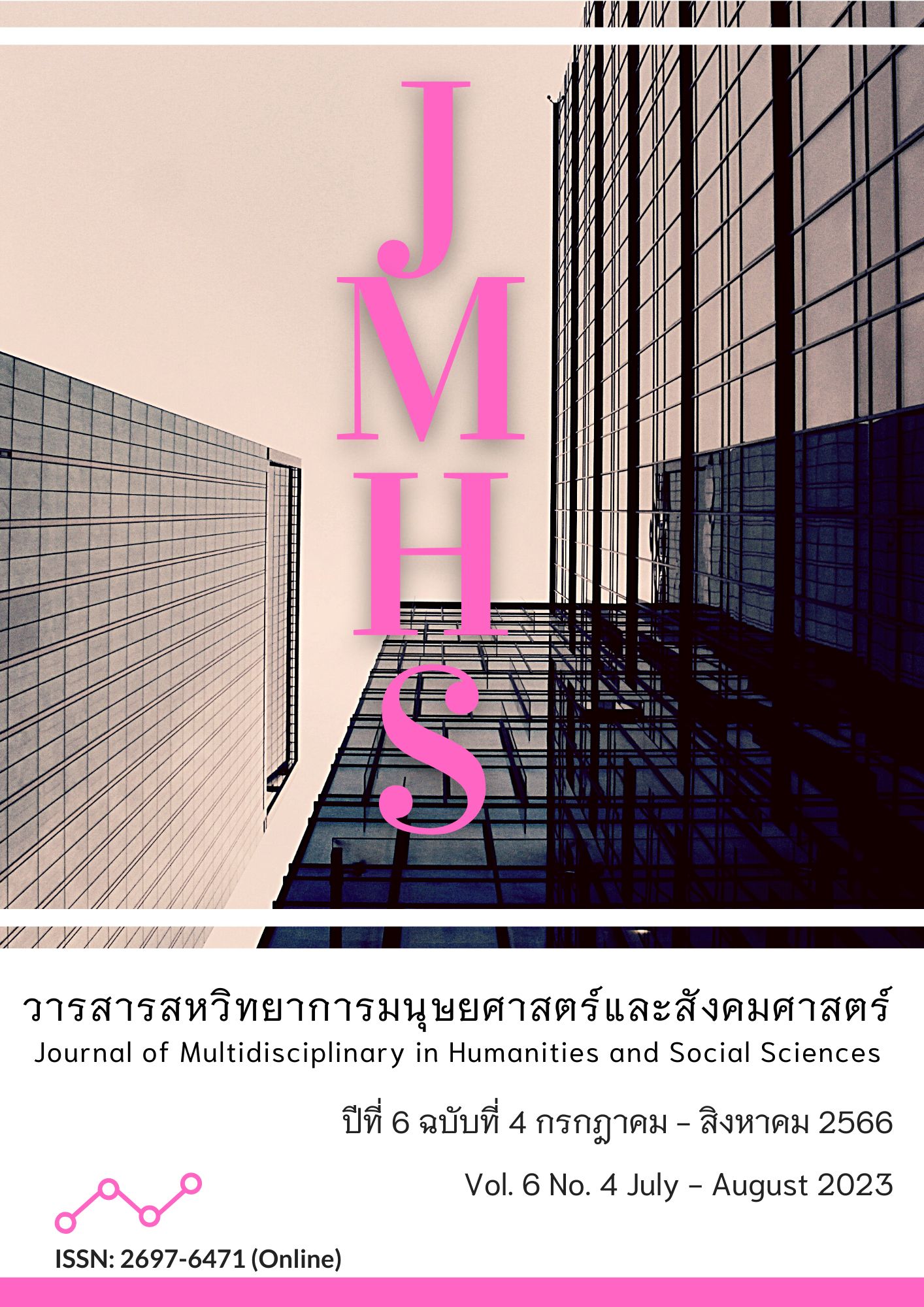Causal Factors Influencing Continuous Purchase Intention of Cosmetics on Shopee Applications of Consumers in Thailand
Main Article Content
Abstract
The article aimed to 1) develop and validate a causal relationship model of continuous purchase intention of cosmetics via Shopee applications in Thailand, and 2) study causal factors Influencing continuous purchase intention of cosmetics via Shopee applications in Thailand. This study was quantitative research. The sample consisted of 380 people who have bought cosmetics on Shopee applications and live in Thailand, by convenience sampling. The tools used in the research were online questionnaires. The statistics used in data analysis were frequency, percentage, confirmatory factor analysis, and the structural equation model.
The results of this research were that the development of the causal relationship models consisted of 4 components: 1) social media interactivity; 2) perceived value; 3) immersive experience; and 4) continuous purchase intention, and the model was consistent with the empirical data to a great extent. The statistics showed CMIN/df = 1.89, CMIN = 199.82, df = 106, GFI = 0.95, AGFI = 0.90, SRMR = 0.02, and RMSEA = 0.05. The final predictive coefficient was 0.96, indicating that the variables in the model can explain the variance of the continuous purchase intention on the Shopee application by 96 percent. It was found that the immersive experience had the most influence on the continuous purchase intention for cosmetics via the Shopee application. Entrepreneurs should consider services that give consumers a good experience when purchasing products or services that create continuous purchase intentions.
Article Details

This work is licensed under a Creative Commons Attribution-NonCommercial-NoDerivatives 4.0 International License.
Views and opinions appearing in the Journal it is the responsibility of the author of the article, and does not constitute the view and responsibility of the editorial team.
References
กรมพัฒนาธุรกิจการค้า. (2565). พาณิชย์ เปิด 10 ธุรกิจที่น่าจับตามองปี 2565. สืบค้นเมื่อ 12 มกราคม 2566, จาก https://www.dbd.go.th/news_view.php?nid=469421710
กิตติทัศน์ ทัศกุณีย์ และ สุพรรณี อินทร์แก้ว. (2559). ปัจจัยที่มีอิทธิพลต่อการตั้งใจซื้อชุดชั้นในวาโก้ซ้ำของผู้หญิงที่มาใช้บริการห้างสรรพสินค้าในเขตกรุงเทพมหานคร. วารสารวิชาการ มหาวิทยาลัยอีสเทิร์นเอเชีย ฉบับสังคมศาสตร์และมนุษยศาสตร์, 6(2), 54-65. สืบค้นจาก
https://so01.tci-thaijo.org/index.php/EAUHJSocSci/article/view/67144
กิตติยา เกิดปลั่ง และ วรรษิดา บุญญาณเมธาพร. (2565). ตัวแบบปัจจัยการรับรู้คุณค่ากับประสบการณ์ทางเศรษฐกิจของนักท่องเที่ยวต่อเทศกาลอาหารท้องถิ่นในจังหวัดภูเก็ต. วารสารรัชต์ภาคย์, 16(45), 297-320. สืบค้นจาก https://so05.tci-thaijo.org/index.php/RJPJ/article/download/254441/173836
ณัฐพัชญ์ วงษ์เหรียญทอง. (2561). 8 สเต็ปของ Customer Experience ที่นักการตลาดควรรู้. GUIDE TO MARKETING. สืบค้นเมื่อ 14 มกราคม 2566, จาก https://www.nuttaputch.com/8-steps-of-customer-experience/
สานิตย์ ศรีชูเกียรติ, อภินนัท์เอื้ออังกูร, สันต์ จันทรนิภา และ จุฑาพร กุมบุรี. (2561). การรับรู้คุณค่าจากส่วนลดราคาในระดับราคาสินค้าที่แตกต่างกัน. วารสารบริหารธุรกิจ, 41(159), 45-59. DOI: 10.14456/jba.2018.13
สิริมา ชำนาญศิลป์ และ ปภาภรณ์ ไชยหาญชาญชัย. (2563). ความสัมพันธ์ระหว่างประสบการณ์ลูกค้าจากช่องทางที่หลากหลาย ภาพลักษณ์ตราสินค้า และความตั้งใจซื้อ: กรณีศึกษาตราสินค้าโพเมโล่. วารสารนิเทศศาสตร์และนวัตกรรม นิด้า, 9(1), 23-43. สืบค้นจาก https://so02.tci-thaijo.org/index.php/jcin/article/download/259755/174282
อัมพล ชูสนุก. (2560). อิทธิพลของการรับรู้คุณคาด้านราคาและดานคุณภาพต่อความไว้วางใจความพึงพอใจการบอกต่อ และการกลับมาซื้อซ้ำของผู้บริโภคสินค้าไทยกูลิโกะ ในเขตกรุงเทพมหานคร. วารสารบริหารธุรกิจศรีนคริทรวิโรฒ. 8(1), 13-26. สืบค้นจาก https://ejournals.swu.ac.th/index.php/MBASBJ/article/view/9393
เดี่ยนลี่ หลี่ และ ชิณโสณ์ วิสิฐนิธิกิจา. (2560). ปัจจัยที่มีผลต่อพฤติกรรมการเลือกซื้อเครื่องสำอางของสุภาพสตรีในเขตกรุงเทพมหานคร. วารสารบัณฑิตศึกษา, 14(67), 121-127. สืบค้นจาก https://so02.tci-thaijo.org/index.php/SNGSJ/article/view/65098/90584
สุรีรักษ์ วงษ์ทิพย์. (2561). เครือข่ายสังคมออนไลน์: กลยุทธ์การสื่อสารการตลาดออนไลน์เพื่อดึงดูดผู้บริโภคยุคดิจิทัล. วารสารบริหารธุรกิจเทคโนโลยีมหานคร, 15(1), 21-36. สืบค้นจากhttps://so04.tci-thaijo.org/index.php/journalmbsmut/article/download/210222/145483/661062
อดิเทพ บุตราช. (2560). ความหมายของคำว่า Social network สังคมออนไลน์. สืบค้นเมื่อ 9 เมษายน 2566, จาก https://sites.google.com/site/socialnetworksangkhmxxnlin05.
วงษ์จันทร์ ไพโรจน์. (2564). การวิเคราะห์องค์ประกอบการรับรู้คุณค่าการบริการของผู้ใช้บริการร้านกาแฟประเภทคาเฟ่ บนถนนนิมมานเหมินท์ จังหวัดเชียงใหม่.วารสารดุสิตธานี, 3(15), 231–232. สืบค้นจาก https://so01.tci-thaijo.org/index.php/journaldtc/article/view/253869
สำนักงานพัฒนาธุรกรรมทางอิเล็กทรอนิกส์. (2565). รายงานผลการสำรวจพฤติกรรมผู้ใช้อินเทอร์เน็ตในประเทศไทย ปี 2565. สืบค้นเมื่อ 12 มีนาคม 2566, จาก
https://www.etda.or.th/getattachment/78750426-4a58-4c36-85d3-d1c11c3db1f3/IUB-65-Final.pdf.aspx
สุมามาลย์ ปานคำ และ เกศกนก สรรพโส. (2565). ปัจจัยเชิงสาเหตุที่มีผลต่อความตั้งใจซื้อน้ำเชื่อมเช-กู บนแอปพลิเคชันช็อปปี้ของผู้บริโภคในประเทศไทย. รังสิตสารสนเทศ, 28(1), 6-21. สืบค้นจาก https://rilj.rsu.ac.th/journal/57/article/274
นิคม ชัยขุนพล. (2560). ลักษณะปฏิสัมพันธ์การสื่อสารจากพฤติกรรมการใช้สื่อสังคมเครือข่ายออนไลน์ของคนไทย. วารสารมหาวิทยาลัยพายัพ, 27(2), 55-65. สืบค้นจาก https://so05.tci-thaijo.org/index.php/pyu/article/download/123291/94135/
พรสวัสดิ์ มงคลชัยอรัญญา และ ธัมมะทินนา ศรีสุพรรณ. (2564). รูปแบบกลยุทธ์ทางการตลาดที่ส่งผลต่อความตั้งใจซื้ออย่างต่อเนื่องของผลิตภัณฑ์กล้วยอบเนย อำเภอกงไกรลาศ จังหวัดสุโขทัย. วารสารวิทยาการจัดการมหาวิทยาลัยราชภัฏพิบูลสงคราม, 3(3), 33-43. สืบค้นจาก https://so03.tci-thaijo.org/index.php/jmspsru/article/view/257728
Hair, J. F., Black, W. C., Babin, B. J., & Anderson, R. E. (2010). Multivariate Data Analysis. (7th ed.). New Jersey: Prentice Hall.
Hair, J. F., Hult, G. T. M., Ringle, C. M., & Sarstedt, M. (2014). A Primer on Partial Least Squares Structural Equation Modeling (PLS-SEM). California: Sage Publications.
Hoelter, J. W. (1983). The Effects of Role Evaluation and Commitment on Identity Salience. Social Psychology Quarterly, 46(2), 140–147. https://doi.org/10.2307/3033850
Hu, L.T., & Bentler, P. M. (1999). Cutoff Criteria for Fit Indexes in Covariance Structure Analysis: Conventional Criteria Versus New Alternatives. Structural Equation Modeling, 6(1), 1–55. DOI: 10.1080/10705519909540118
Lin, J., Li, T., & Guo, J. (2021). Factors Influencing Consumers’ Continuous Purchase Intention on Fresh Food E-Commerce Platforms: An Organic Foods-Centric Empirical Investigation. Electronic Commerce Research and Applications, 50, 1-15. https://doi.org/10.1016/j.elerap.2021.101103
Joreskog, K. G., & Sorbom, D. (1984). Advances in Factor Analysis and Structural Equation Models. Lanham: Rowman & Littlefield Publishers.
Kline, R. B. (2011). Principles and Practices of Structural Equation Modeling. (3rd ed.). New York: The Guilford Press.
Rodriguez, A. I., & Meseguer, A. A. (2018). Imagine, Feel "There", and Flow! Immersive Experiences on M-Facebook, and Their Affective and Behavioral Effects. Information Technology People, 32(4), 921-947. DOI: 10.1108/ITP-10-2017-0358.
Schreiber, J. B., Stage, F. K., King, J., Nora, A., & Barlow, E. A. (2006). Reporting Structural Equation Modeling and Confirmatory Factor Analysis Results: A Review. The Journal of Educational Research, 99(6), 323–337. https://doi.org/10.3200/JOER.99.6.323-338
Schumacker, R. E. & Lomax, R. G. (2004). A Beginner's Guide to Structural Equation Modeling. (2nd ed.). New Jersey: Lawrence Erlbaum Associates Publishers.
Thompson, B. (2004). Exploratory and Confirmatory Factor Analysis: Understanding Concepts and Applications. American Psychological Association. https://doi.org/10.1037/10694-000
Tian, H., & Lee, Y. (2022). Factors Affecting Continuous Purchase Intention of Fashion Products on Social E-Commerce: SOR Model and The Mediating Effect. Entertainment Computing, 41, 100474. http://doi.org/10.1016/j.entcom.2021.100474
Ullman, M. T. (2001). The Declarative/Procedural Model of Lexicon and Grammar. Journal of Psycholinguistic Research, 30(1), 37–69. https://doi.org/10.1023/A:1005204207369
Wu, H. Y., Chen, J. K., & Chen, I. S. (2017). Performance Evaluation of Aircraft Maintenance Staff Using a Fuzzy MCDM Approach. International Journal of Innovative Computing, Information and Control, 8, 3919-3937. http://dx.doi.org/10.2139/ssrn.3104472


